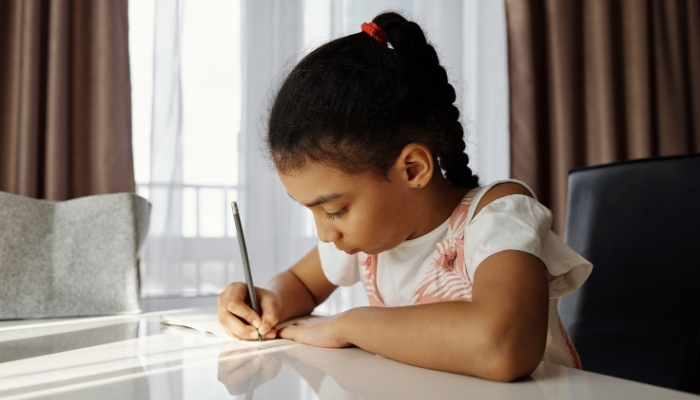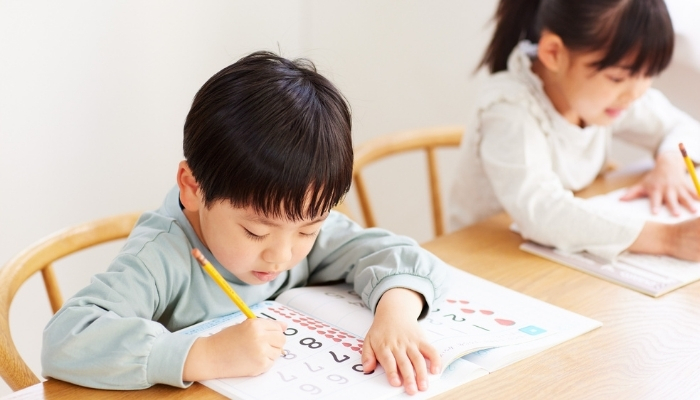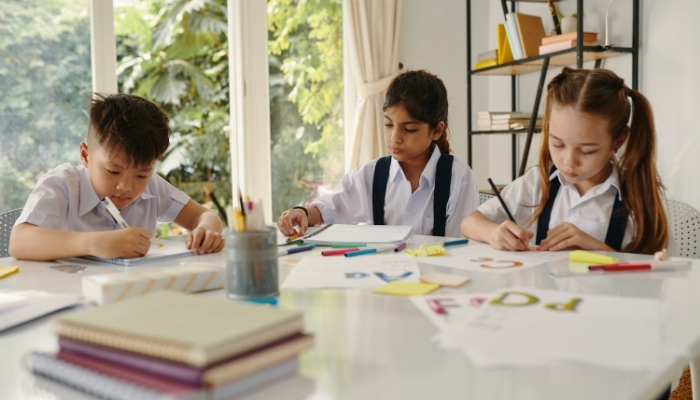Imagine a group of little ones huddled around a small table, crayons rolling, papers scattered, and stories coming to life in every scribble. One child writes about their pet, another proudly sounds out their first sentence. That’s the beauty of a kindergarten writing center, it’s where imagination blossoms into words.
According to the Australian Early Development Census (2024), only 52.9 % of children start school on track across all key developmental areas, including early literacy. This shows how important it is to nurture writing confidence and creativity from the very beginning.
A well-designed writing center gives children the freedom to explore language, express themselves, and celebrate progress at their own pace.
In this blog, we’ll share how to create a kindergarten writing center that nurtures curiosity, builds literacy skills, and helps every child fall in love with writing.
Key Takeaways
-
A thoughtful kindergarten writing center turns early literacy into a fun, hands-on experience that builds creativity, motor skills, and foundational writing confidence.
-
Rotating materials and child-led activities keep the writing center kindergarten engaging, helping children see writing as play instead of routine schoolwork.
-
A collaborative kindergarten writing station strengthens communication, confidence, and teamwork through shared stories and group writing experiences.
-
Parents can recreate a simple kindergarten writing center at home, connecting classroom learning with everyday creativity and consistent skill growth.
-
The FunFox Writers Club extends these foundations with interactive lessons that make writing engaging, structured, and confidence-boosting for every young learner.
Why a Writing Center Matters in Kindergarten
A kindergarten writing center is more than a table filled with pencils and paper; it’s a space where young minds learn to express themselves through words, drawings, and stories. At this age, children are discovering that their ideas have meaning, and giving them the right environment helps those ideas come to life.

1. Building Early Literacy Skills
In the early years, children move from scribbling to forming letters and words. A well-designed writing center kindergarten supports this progression through fun, hands-on practice.
Activities like labeling classroom items, tracing names, or writing short sentences help children strengthen fine motor skills and letter recognition, essential foundations for reading and writing success.
2. Encouraging Independence and Confidence
When children visit the writing station in kindergarten, they make choices, what to write, what tools to use, and how to express their thoughts.
This freedom builds confidence and fosters independence. Over time, they start to see themselves not just as students, but as writers with stories worth sharing.
3. Making Writing Enjoyable
Traditional worksheets can make writing feel like a chore. In contrast, creative kindergarten writing station ideas, such as story prompts, picture cards, and themed writing tasks, make the experience playful and engaging.
When writing feels fun, children naturally practice more often, strengthening both skill and enthusiasm.
4. Supporting Communication and Social Skills
A writing center also encourages collaboration. Children can share stories, read their work aloud, or create group projects.
These writing center activities for kindergarten not only develop literacy but also help build communication, empathy, and teamwork, vital skills for lifelong learning.
5. Bridging Home and School Learning
Parents can recreate a simple kindergarten writing center at home using everyday materials like notebooks, crayons, and word cards. This connection between school and home keeps learning consistent and helps children view writing as part of everyday life, not just a classroom task.
A thoughtfully designed kindergarten writing center turns learning into a joyful experience. It helps children see writing as an adventure, one where imagination, language, and confidence grow together.
If your little writer is ready to go beyond the classroom and explore storytelling, check out 7 Steps To Successful Writing: Tips To Master The Art Of Creative Writing for simple, practical ways to guide them.
Key Principles to Keep in Mind Before You Set Up
Before setting up your kindergarten writing center, focus on what makes the space inviting and effective for young writers.

-
Make It Child-Friendly: Keep supplies within easy reach. Low shelves, labeled bins, and colorful signs help children use the writing center kindergarten independently.
-
Blend Structure and Freedom: A good writing station kindergarten gives direction but leaves room for creativity. Use simple prompts, but let kids explore their own ideas too.
-
Keep It Fresh: Rotate paper types, word cards, and writing center ideas for kindergarten regularly. New materials spark curiosity and keep engagement high.
-
Encourage Ownership: Let children restock, decorate, or display their work. Involving them makes the kindergarten writing center feel personal and fun.
Creating a thoughtful writing center helps children see writing as exciting, achievable, and uniquely their own.
Setting Up Your Kindergarten Writing Center
Designing a kindergarten writing center is about creating a space that sparks creativity while keeping things simple and accessible. Here’s how to get started step by step.
1. Choose the Right Location
Pick a quiet, well-lit spot with enough space for a few children to work comfortably. Avoid busy corners where distractions are high.
Tip: Use a small table or even a cozy rug area; children love having their own “writing zone.”
2. Organize Materials
Stock up on pencils, crayons, paper, and erasers. Add support tools like alphabet charts, word walls, and picture dictionaries.
Tip: Keep items in labeled baskets so children can grab what they need independently, a must for any writing center kindergarten setup.
3. Add Visual Inspiration
Display children’s work, writing samples, and colorful posters that highlight letters or word families.
Tip: Rotate displays often to match new kindergarten writing station ideas or classroom themes. It keeps the area fresh and exciting.
4. Create Themed Writing Stations
Divide your writing station kindergarten into mini zones, such as a story corner, labeling station, or letter-writing area.
Tip: Themes like “My Family,” “Animals,” or “Seasons” help children connect writing to real-life experiences.
5. Keep It Flexible
Your kindergarten writing center should grow with your students. Update materials as their skills progress, from tracing to storytelling.
Tip: Observe how children use the space. If one activity gets all the attention, refresh others to balance engagement.
6. Make It Inviting
Add small touches, colorful bins, soft seating, or a “Writer of the Week” wall to make the space welcoming.
Tip: Let children help decorate! It builds ownership and excitement.
A well-organized kindergarten writing center doesn’t need to be elaborate. With the right setup and thoughtful details, it becomes a favorite spot where little writers learn, create, and grow.
If your child is beginning to turn ideas into little stories, explore Kindergarten Story Writing Steps, Tips, and Techniques for Kids to guide them from imagination to expression.
Writing Center Activities (Writing Station Activities for Kindergarten)
Once your kindergarten writing center is ready, the next step is choosing activities that encourage both creativity and skill development.
Below are engaging and age-appropriate writing center ideas for kindergarten that you can rotate through the year to keep children excited about writing.

1. Writing Beginning Sounds
-
Children identify the first letter in familiar words or pictures.
-
Use picture cards (e.g., dog, sun, hat) for children to label with the correct beginning sound.
-
Encourages letter recognition, phonemic awareness, and sound-symbol connection.
2. Stretch and Write Words
-
Learners slowly say words aloud and record the sounds they hear.
-
Helps children move from writing single letters to full words.
-
Strengthens early spelling and builds independence in writing.
3. Labeling Pictures and Objects
-
Students label images, classroom items, or themed illustrations.
-
Promotes vocabulary development and strengthens the link between words and meaning.
-
Builds fine motor coordination and handwriting fluency.
4. Writing Simple Lists
-
Children create short lists such as “My favorite foods” or “Things I like to play.”
-
Encourages organization and teaches that writing has real-world uses.
-
Suitable for individual or group activities.
5. Handwriting and Letter Practice
-
Focuses on letter formation, spacing, and control.
-
Includes tracing, copying, or forming letters independently.
-
Reinforces correct pencil grip and muscle memory for smooth writing.
6. Building and Completing Sentences
-
Students combine word cards to form complete thoughts (e.g., “The cat can run.”).
-
Reinforces grammar, sentence order, and comprehension.
-
Gradually shifts from guided structure to independent writing.
7. Creating Pattern Books
-
Children write short, repetitive sentences following a simple pattern (e.g., “I see a…”).
-
Encourages sentence rhythm and sight-word recognition.
-
Builds confidence as children complete a “book” they can read and share.
8. Story Starters
-
Provides visual or written prompts to inspire storytelling.
-
Encourages imagination, sequencing, and creative expression.
-
Ideal for students beginning to write multiple connected sentences.
9. Writing Letters and Cards
-
Children compose short notes, thank-you cards, or friendly letters.
-
Strengthens communication skills and emotional expression.
-
Reinforces correct sentence structure in meaningful contexts.
10. Mix and Fix Sentences
-
Students rearrange scrambled words to form logical sentences.
-
Improves understanding of syntax and sentence order.
-
Supports comprehension and reinforces correct grammar.
11. Real-World Writing Tasks
-
Includes authentic activities such as writing shopping lists, signs, menus, or class notices.
-
Helps children see writing as useful and purposeful in daily life.
-
Encourages connection between writing and everyday experiences.
A thoughtfully planned kindergarten writing center with diverse writing station activities for kindergarten builds the foundation for confident, expressive young writers.
Each activity helps children explore language, develop fine motor skills, and find joy in communicating their ideas through writing.
Every great writer starts with the basics, but true growth comes from learning what makes writing powerful. Discover more in Introducing the 6 Traits of Writing for Primary Grades.
Troubleshooting & Keeping the Center Engaging
Even the best-designed kindergarten writing center can lose momentum over time. Children’s interests evolve quickly, and without small adjustments, engagement can dip. Regularly reviewing your setup, refreshing materials, and encouraging variety helps sustain curiosity and excitement.
Here are a few common challenges you might face, and quick, practical ways to solve them.
|
Challenge |
Why It Happens |
Quick Fix |
|
Children lose interest |
Activities feel repetitive or too easy. |
Rotate themes, update prompts, and add seasonal writing center ideas for kindergarten. |
|
Messy or disorganized space |
Materials aren’t labeled or easily reachable. |
Use labeled bins, low shelves, and student helpers to manage the writing center kindergarten. |
|
Uneven participation |
Some children dominate while others hesitate. |
Introduce small group turns and partner tasks to balance the use of the kindergarten writing station. |
|
Limited time or attention |
Sessions run too long or lack variety. |
Keep activities short (10–15 mins) and switch between writing, drawing, and sharing. |
|
Lack of motivation |
Tasks feel like “work,” not play. |
Add creative options, story cards, mini books, or letter writing to make the kindergarten writing center fun and purposeful. |
After fine-tuning your classroom writing center, why stop there? With a few simple tweaks, you can recreate the same engaging experience right at home.
Adapting the Writing Center for Home / Hybrid Use
A kindergarten writing center isn’t just for classrooms; it can easily fit into home or hybrid learning. With a few simple adjustments, parents can create a welcoming space that encourages daily writing habits and supports school-based learning.

1. Choose a Calm, Accessible Space
-
Select a quiet corner with good lighting and minimal distractions.
-
Use a small table or lap desk for comfort.
-
Keep supplies organized in labeled boxes or trays.
2. Use Simple, Everyday Materials
-
Stock essentials like paper, crayons, markers, glue, and scissors.
-
Include recycled items like envelopes or old notebooks.
-
Add word cards or alphabet charts for quick reference.
3. Keep Activities Short and Fun
-
Plan 10–15 minute writing sessions to match attention spans.
-
Alternate between drawing, labeling, and short sentences.
-
Use prompts based on home life, pets, family, or daily routines.
4. Encourage Family Involvement
-
Parents can model writing letters, lists, or notes.
-
Celebrate effort over accuracy to build confidence.
-
Display writing on walls or a fridge to show pride and progress.
5. Connect Home and School Learning
-
Mirror classroom themes in the writing center kindergarten (e.g., “My Family,” “Seasons”).
-
Share finished work with teachers or peers online.
-
Reinforce the idea that writing happens everywhere, not just at school.
A well-planned kindergarten writing station at home nurtures creativity, consistency, and connection between parents, teachers, and learners, helping every child see themselves as a writer, wherever they are.
Looking for ways to keep your students’ creativity alive during writing sessions? Try 50 Creative Writing Exercises to Inspire Younger Writers for ready-to-use classroom ideas.
From Scribbles to Stories: How FunFox Nurtures Young Writers
At FunFox, we believe every child has a story to tell. Whether they’re exploring letters at a kindergarten writing center or building full stories in primary school, our approach makes writing fun, structured, and confidence-boosting. Here’s how FunFox supports young writers every step of the way:

-
Interactive Learning That Feels Like Play: Our Writers Club transforms learning into an adventure. Through games, storytelling, and small-group sessions, children in the writing center kindergarten age group discover how exciting writing can be, with no pressure, just creativity and joy.
-
Building Strong Foundations: We teach core writing skills like grammar, punctuation, and sentence structure in ways children actually enjoy. Each lesson in our kindergarten writing station builds toward long-term literacy success, helping students become confident communicators.
-
Small Groups, Big Growth: Every class has a maximum of six students, giving teachers time to focus on each child’s strengths and needs. This provides personal attention, a key part of the FunFox Way.
-
Real-Time Feedback That Inspires: Children receive continuous feedback during lessons, helping them improve while celebrating every achievement. This immediate encouragement keeps motivation high and builds self-belief.
-
Flexible Learning That Fits Family Life: Our Writers Club runs through weekly one-hour Zoom sessions that fit easily into busy schedules. With class recordings, your child can review lessons anytime, and learning stays flexible and consistent.
-
Led by Passionate Teachers: FunFox teachers are experienced, caring educators trained in our proprietary approach, The FunFox Way. They know how to make learning enjoyable while nurturing lifelong writing skills.
-
An Inclusive Community of Learners: We welcome students of all abilities and backgrounds, from those who find writing challenging to those who already love it. Every child is encouraged to explore, express, and grow.
Conclusion
It’s completely normal for a kindergarten writing center to need a little trial and error before it truly clicks. What matters most is giving children the structure and space to explore their ideas freely. Every label, list, and story they write builds confidence, and that’s where their creative voice begins to shine.
As your child’s writing skills grow, expert guidance can turn that early curiosity into lasting ability. The FunFox Writers Club offers engaging, small-group lessons that make writing enjoyable, structured, and confidence-boosting, just like a well-run writing center kindergarten should be.
Ready to turn your child’s kindergarten writing station into a space where creativity thrives?
Book a free trial class with the FunFox Writers Club today, and watch your young writer fall in love with writing!
FAQs About Kindergarten Writing Center
1. Can a writing center kindergarten work with mixed ability groups?
Yes, a well-designed kindergarten writing center can support children at different levels simultaneously. You can include differentiated tasks (e.g., tracing, labeling, sentence building) so that each child works at the right challenge. Mixing ability this way encourages peer support and lets children progress at their own pace.
2. What if my child resists using the kindergarten writing station at home?
That’s common. To help, place the writing station kindergarten in a welcoming, low-pressure corner. Let the child choose prompts or tools. Use themed or familiar topics (pets, family) to make it feel fun rather than a chore. Over time, they’ll see the writing center as a place they enjoy returning to.
3. How often should I refresh or rotate writing center kindergarten materials?
To prevent boredom, aim to rotate or update materials every 1–2 weeks. Swap in seasonal prompts, new vocabulary cards, or novel paper styles. Frequent small changes keep the kindergarten writing center feeling fresh and encourage children to explore new tasks.
4. How can I keep the writing center engaging when children’s attention wanes?
Shorten activities (10–15 mins), alternate between drawing and writing, or switch tasks mid-session to re-energize focus. Introduce mini “challenge grams” or surprise prompts. Small shifts like these can help sustain interest in your writing center kindergarten.
5. How does FunFox support skills developed in a kindergarten writing center?
FunFox builds on what children practice in a kindergarten writing center by offering structured small-group lessons, creative prompts, and real-time feedback. Our Writers Club helps reinforce letter formation, sentence building, and expression, turning those early writing experiences into confident, skilled writing over time.















